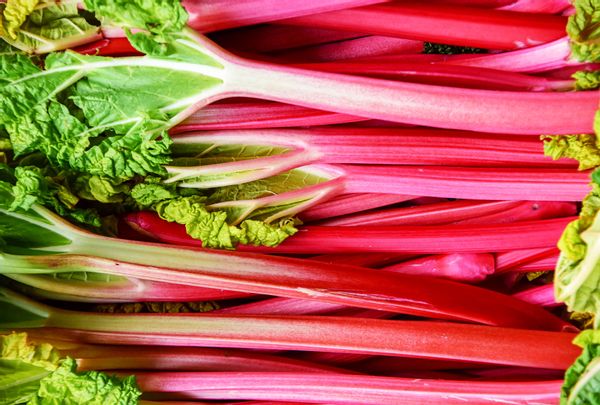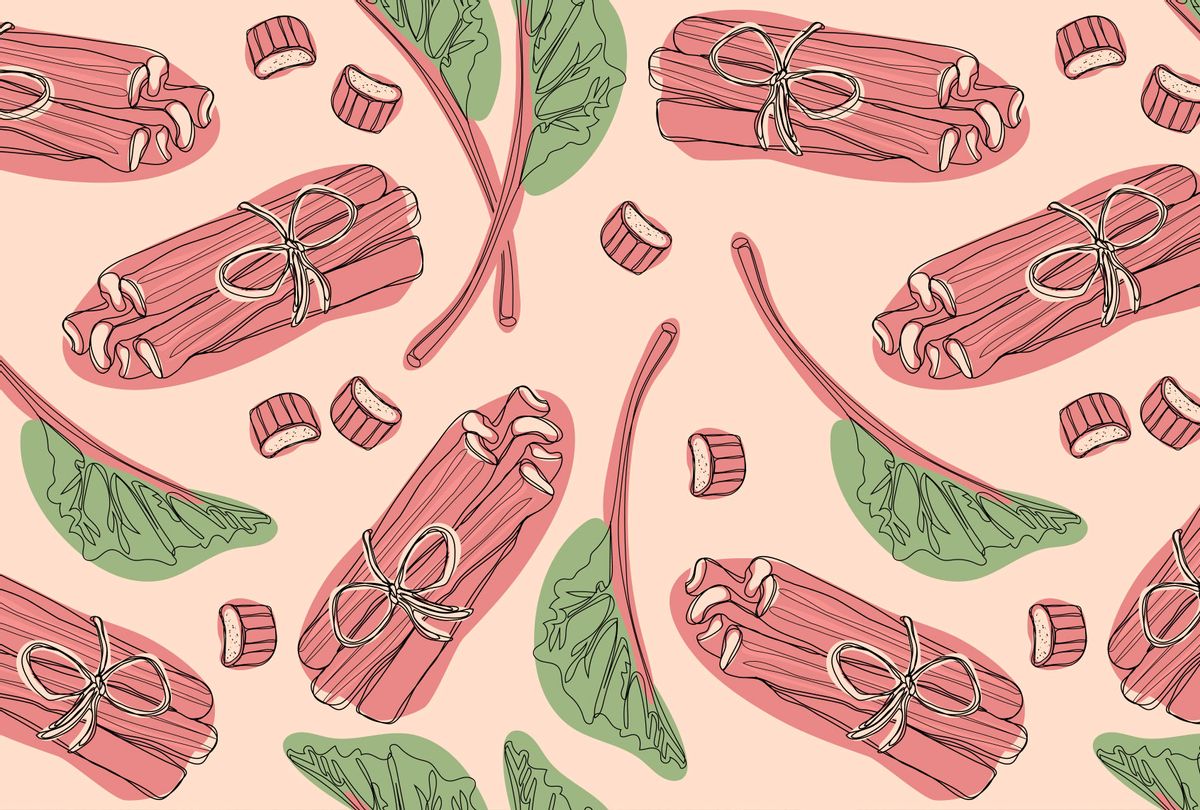Rhubarb can be a curious thing. While many are ostensibly aware of it, this peculiar produce is certainly neither the most common nor the most popular ingredient. Looking a bit like celery's crimson cousin, it's the inverse-tomato; a vegetable masquerading as a fruit, often playing second fiddle to strawberry or other more ubiquitous fruits in tarts, crumbles and crisps. Rhubarb rarely steps into the spotlight on its own volition — until now.
The perennial ruby vegetable signals the onset of spring, a surefire indicator that the weather is warming and flowers are blossoming. Its color is a vibrant ruby-red, and the inside of the stalks are an aloe vera-like, deep-greenish and verdant ala cucumber. The peculiar stalks originated in central Asia; they were originally used strictly for medicinal purposes in traditional Chinese medicine.
In fact, rhubarb may date back as far as 2700 BC. The BBC notes that the crop was initially transported from China and Siberia to Italy in the 13th century before being brought to England by the early 1600s. It also became a highly desired bartering tool and currency; it's said to have been worth as much as saffron. The first known published mention of sweetened rhubarb is in a 1760 cookbook by Hannah Glasse, according to Foods of England.
RELATED: More than a pie filling — here's everything you need to know about cooking with rhubarb
At some point, sugarcane cultivation resulted in a bounty of sugar, which someone happened to combine with rhubarb and voila — the idea of its primary inclusion in desserts came to fruition. This may also be because it's not often eaten in its raw form — it has a biting, astringent note. However, when cooked down with some sugar or honey, its harsh edges are softened, it breaks down and becomes jam-like and its flavor becomes appealing, bright and decisively fruity. The rhubarb-sugar pairing has clearly helped to frame the way that the vegetable is understood, served and enjoyed in the present day.
Be sure to steer clear of the leaves — they actually contain highly poisonous toxins. Trim them, immediately discard them and keep your focus on those beautiful stalks. Aside from its culinary purposes, rhubarb was also used for its medicinal benefits for many years. As far as the whole fruit/vegetable dichotomy, Taste of Home notes that the U.S. Customs Court deemed rhubarb a fruit instead of a vegetable in 1947. This was due to the differing tax rates between the two produce classifications. What a world, huh?!

Check out a close-up of this unique red stalk. (Photo by Getty Images)
Now that you're ready to get to cooking, check out my flavorful recipes for sausage and rhubarb sandwiches and roasted rhubarb-tomato sauce. Then, stick around for a crash course in rhubarb coulis, purées and syrups.
***
This originally started as a play on a relative standard rhubarb barbecue sauce before it took on a life of its own. It's very complex and deep, with tons of different, nuanced flavor notes; it's delicious with chicken, steaks and ribs; it's excellent either grilled or roasted; plus, it's a great marinade. Don't skimp on applying this sauce — chicken and ribs especially benefit from a lot of it! Feel free to reapply multiple times throughout the cooking process, and cook until the sauce is sticky, browned and imbued into the protein.
Recipe: Roasted Rhubarb-Tomato Sauce
Ingredients:
- 2 tablespoons extra virgin olive oil
- 3 large tomatoes, cored and roughly chopped
- 4 stalks rhubarb, leaves removed, roughly chopped
- 1 onion, roughly chopped
- 3 garlic cloves, smashed
- Kosher salt
- Freshly cracked black pepper
- 1 tablespoon tomato paste
- 1 teaspoon soy sauce
- 1.5 teaspoons molasses
- 1 tablespoon honey
- 1 teaspoon apple cider vinegar
- 1/2 teaspoon chili powder
- 1/2 teaspoon sumac
- 1/2 teaspoon paprika
- 1 teaspoon cocoa powder
- Water or stock
Directions:
- Preheat oven to 400 degrees. Combine tomato, rhubarb, onion, garlic, salt and pepper; and spread evenly on sheet tray. Cook 20-30 minutes, or until tender and lightly browned.
- Carefully transfer roasted fruits and vegetables to a large, heavy-bottomed saucepan. Heat over medium heat, add tomato paste and caramelize for 5 minutes. (Be careful not to burn, but you want to get some significant color.)
- Add soy, molasses, honey and apple cider vinegar; stir. Add chili powder, sumac, paprika and cocoa powder. Stir, and cook 10-15 minutes until warmed through. Taste for seasoning; add salt and pepper. Let cool.
- Once cooled, transfer to blender or food processor and blend until smooth. Add water or vegetable stock until sauce is the consistency of barbecue sauce. Store in an airtight container, or use immediately.
***
This is in the vein of sausage and peppers — you just swap out the peppers for rhubarb! The savory roasted grapes offer an amazing pop of flavor.
Recipe: Sausage and Rhubarb Sandwiches with Roasted Balsamic-Thyme Grapes
Ingredients:
- Extra virgin olive oil
- 4 links sweet or spicy Italian sausage, split in half
- 4 stalks rhubarb, leaves removed, cut into 4-inch hunks
- Kosher salt
- Freshly cracked black pepper
- 1 bunch grapes, washed and dried
- 1 onion, halved, peeled, and sliced
- 3 garlic cloves, smashed
- 2 tablespoons balsamic
- Fresh thyme, stripped from stems
- 1-2 baguettes
- Sliced provolone, optional
Directions:
- Preheat oven to 400 degrees. On a sheet tray, place sausage and rhubarb. Drizzle with olive oil, salt and pepper. Cook until sausage is deeply browned and rhubarb is tender.
- On a separate sheet pan, mix grapes with balsamic, thyme, onion, garlic, olive oil, salt and pepper. Cook until some grapes have burst and balsamic has reduced.
- Slice baguette into thirds, and cut each in half. Pile sausage, rhubarb, grapes and provolone (if using). Toast in oven for 5 minutes, until bread is beginning to crisp and the filling is hot.
***
The Wonderful World of Rhubarb Syrups, Coulis, and Purées
How to make a standard rhubarb syrup:
- 2-3 stalks rhubarb, leaves removed, roughly chopped
- 1/4 cup granulated sugar
- Water
- In a saucepan over medium-low heat, combine rhubarb, sugar and a small amount of water. Cook for 15-20 minutes, or until rhubarb is fully tender. Strain with a fine-mesh strainer; discard solids. Store syrup in an airtight container.
How to make a honey-orange syrup variation:
- 2-3 stalks rhubarb, leaves removed, roughly chopped
- 1.5 tablespoons honey
- Zest of 1 orange
- Juice of 1 orange
- In a saucepan over medium-low heat, combine all ingredients. Cook for 15 minutes, or until rhubarb is fully tender. Strain with a fine-mesh strainer; discard solids. Store in an airtight container.
Other variations:
- If you purée the mixture and then strain, you end up with a coulis.
- If you simply purée the mixture, it becomes a rustic, chunky jam.
Now, let's put these wonderful creations to use!
How to use a syrup:
- Mix into spirits or liquors, top with seltzer or ginger-ale, garnish with nutmeg (It's especially delicious with vermouth and champagne!)
- Mix with juices (It pairs very well with passionfruit and strawberry!)
- Add to a shrub
- Mix into lemonades or iced teas (Fresh mint is a delicious addition!)
- Blend into cake, pound cake or cupcake batters — blend until homogeneous for a pink-tinted cake, or pour a drizzle into batter just before baking for a striking, ruby-streaked cake
- Blend into whipped cream or buttercream
- Stir into a glass of milk or buttermilk
How to use a coulis:
- Drizzle over pavlova or meringue
- Add to yogurt, fool or parfait
- Drizzle over pancakes or waffles
- Drizzle over ice cream
- Serve with cake
- Drizzle over cheesecake or key lime pie
How to use a purée:
- Use as an accouterment on a cheese platter or with charcuterie
- Serve with whipped goat cheese, crusty bread and/or crackers
- Serve with grilled chicken or fish
- Blend into a smoothie
- Top crostini
- Blend into a margarita



Shares